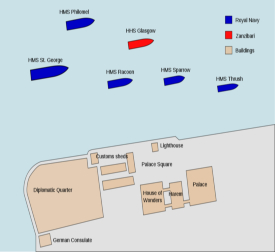All Rights Reserved, 2000 - 2017
Created by:
Torrence Royer
Comments are welcome.
Please leave a note in the public GUEST BOOK
or send a private Email to:
Barghash@msn.com

Zanzibar Courage
A longer look at the Shortest War.
Introduction:
The
war
in
1896
between
Zanzibar
and
Great
Britain
has
been
recorded
as
history's
shortest
and
is
often
dismissed
as
a
sort
of
comic-opera
event
not
worthy
of
serious
study.
However,
the
story
of
this
war
can
reveal
enduring
lessons,
and
its
small
scale
can
help
bring
focus
to
some
of
the
larger
issues
present
whenever political violence occurs.
Zanzibar
has
been
conquered
many
times
in
its
history,
but
time
after
time
the
local
population
would
reassert
themselves.
Tranquility
would
prevail
only
when
the
people
felt
they
could
engage
the
rulers
in
a
meaningful
dialogue
about
how
they
were
to
be
ruled
and
have
a
say
about
who
should
be
among
the
leading
personalities
in
Zanzibar.
These
values
clashed
with
the
"manifest
destiny"
values
of
Imperial
Britain
of
that
time.
During
that
clash,
brief
as
it
was,
Zanzibar managed to send her cry for self-determination echoing through history.
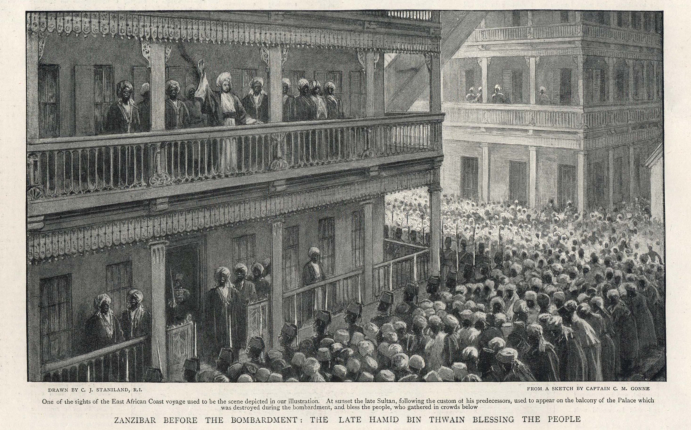
The Setting:
Just
before
noon
on
August
25,
1896
Seyyid
Hamid
bin
Thuwaini
bin
Said,
Sultan
of
Zanzibar,
Pemba, Mafia, Lamu and all "Syidi" (the mainland "coastal strip"), died.
The
Omani
settlers
on
Zanzibar,
including
the
Royal
family
and
the
other
prominent
family/clans,
had
a
long
history
of
self-determination
when
it
came
to
selecting
new
rulers.
This
tradition
was
rooted
in
the
inter-clan
consensus
building
process
that
developed
around
the
selection
of
an
Imam.
As
far
back
as
the
year
751
the
Imam
of
Oman
was
"elected"
by
clan
elders.
This
consensus/selection
process
was
an
early
example
of
a
somewhat
more egalitarian system, in an age of despots.
The
Zanzibari
dynastic
succession
process
that
was
extrapolated
from
these
earlier
religious
election
practices
could
be
spiced
with
a
good
deal
of
blood
and
swash.
Competition
among
the
leading
personalities
of
the
strongest
coalitions
might
be
fierce.
In
1859,
the
system
was
described
by
the
British
as
follows;
"
All
male
heirs
were
equally
eligible
for
the
succession...
might,
coupled
with the election by the Tribe, is the only right.
"
Sultan
Barghash,
when
asked
about
Zanzibari
succession
practices,
put
it
succinctly
by
saying
the
right
to
inherit
the
crown
fell
to
the
contender with "the longest sword".
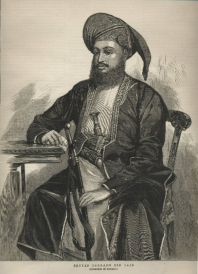
The
contender
with
the
longest
sword
when
Seyyid
Hamid
died
was clearly Khalid bin Barghash.
A
young
man
of
29,
Seyyid
Khalid
had
the
backing
of
most
of
the
large
land
owners
and
local
business
leaders.
He
was
acceptable
to
the
indigenous
WaHamadi
and
WaTumbatu
populations
and
he
was
a
son
of
nobility.
He
was
not
however
acceptable
to
the
British.
Their
man
was
Seyyid
Hamoud
bin
Mohamed,
a
nephew
of
the
Sultan
of
Oman
and
a
man
much
interested
in
modern
ways.
The
British
believed
he
would
be
easier
to
work
with
than
the
independent minded Khalid.
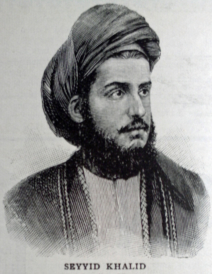
The
Zanzibaris
saw
the
British
position
as
blatant
interference
in
the
succession,
an
affront
to
their
dignity
and
their
traditional
rights.
Khalid
was
after
all
a
grandson
of
the
founding
father
of
the
Country,
Sayyid
Said.
He
had
passed
muster
with
the
clans.
He
had
the
loyalty
of
the
largest
military
force
on
the
island
and
by
4:00
pm
on
that
Tuesday
he
fulfilled
the
final
tests
of
inheritance,
he
took
possession
of
the
palace
and
gained
control
of
the
harbor
and
most
of
the
capital city.
The
British
were
furious.
They
began
to
prepare
for
war.
There
were
already
two
Royal
Navy
warships
at
anchor
in
the
harbor
when
the
old
Sultan
died.
The
British
government
immediately
ordered
their
top
Admiral
in
the
Indian
Ocean
to
rush
to
Zanzibar.
His
flagship
and
two
other
nearby
warships
were
vectored
towards
the
Islands,
at
top
speed
they
would
all
rendezvous
in
Zanzibar in less than 2 days.
That
order
went
out
on
the
evening
of
August
25th,
the
Zanzibari
men
at
the
Palace
compound
had
the
next
40
hours
to
contemplate
their
fates.
Was
it
to
be
fight
or
flight?
Would
they
obey
Seyyid
Khalid’s
order
to
stand
their
ground,
to
wait,
and
stare
resolutely
into
the
eyes
of
the
huge
Imperial Lion that was gathering itself to leap upon them?

The Forces:
The dead Sultan had a palace guard
that had been considerably
strengthened and re-equipped over the
last few years of his reign. These now
crack companies were supplemented by
artillery detachments manned by
Zanzibari, Arab, Baluchi and Persian
gunners (and also possibly some
Egyptian artillerymen).
Altogether
this
Royal
Guard
totaled
almost
1000
troops.
This
force,
to
a
man,
went
over
to
Khalid
when
the
struggle for succession began.
In
addition,
Seyyid
Khalid
brought
with
him
about
300
organized
and
armed
relatives
and
personal
retainers
when
he
occupied
the
palace.
Once
he
held
the
palace
and
the
British
demands
became
known
an
additional
1,500
Zanzibari
irregulars
flocked
to
his
colors.
Combined,
the
so-called
Usurpers
totaled 2,800 men.
These
men
set
to
fortifying
Beit
El-Hukm
Palace
and
the
harbor-side
frontage
of
that
compound.
Many cannon were included in those hasty fortifications, along seafront square.

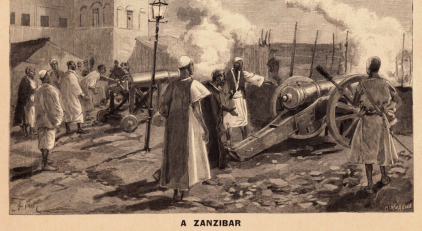
The Government troops
On
the
other
side,
the
Zanzibar
regular-army
(government)
troops
numbered
about
900
men.
They
were
organized
in
two
battalions
(plus
a
band)
and
were
led
by
British
officers
on
loan
to
the
old
Sultan.
The
leader
of
this
force
was
a
onetime
British
naval
lieutenant
who
had
risen
to
the
rank
of
General of the Army of the Sultan of Zanzibar. His name was Lloyd Mathews.
Mathews
drilled
his
troops
rigorously
and
they
had
demonstrated
discipline
and
good
fighting
spirit
during
the
occasional
punitive
expeditions
on
the
coast,
which
they
undertook
at
the
behest
of
the
Sultan
(and/or
the
British
Resident).
They
were
an
infantry
force,
well
equipped,
but
with
no
heavy
guns.
Serious
concerns
arose
among
some
of
the
British
diplomats
as
to
the
loyalty
to
these
"loyalist
troops".
The
troops
apparently
showed
little
sympathy
for
foreign
meddling
in
local
politics.
However,
they
were
professionals
and
General
Mathews
correctly
asserted
that
'his'
men
would
follow
any
orders he gave them.
Mathews
and
his
outnumbered
force
took
up
defensive
positions
within
the
town.
They
dug-in
most
strongly
around
the
diplomatic
quarter
of
the
city,
just
south
of
the
Palace
held
by
the
usurpers.
Mathews
also
made
some
efforts
to
block
the
approaches
to
town,
this
in
an
effort
to
prevent
people
in
the
countryside
from
joining the fray.
Then they waited for reinforcements.
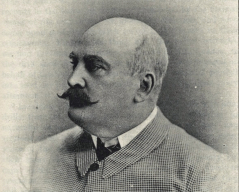
The Royal Navy
Reinforcements
to
support
the
Zanzibar
government
infantry
came
almost
immediately,
from
the
Royal Navy.
Anchored
in
the
Harbor
at
the
time
of
the
old
Sultans
death
were
the
British
Light
Cruiser
H.M.S.
Philomel and the gunboat H.M.S. Thrush.
By
5:30
that
same
evening
they
were
joined
by
the
Thrush's
sister
ship,
the
H.M.S.
Sparrow.
After
nightfall
on
that
Tuesday
small
contingents
of
British
marines
from
those
3
vessels
landed
in
town,
near
Shangani
point,
and
joined
with
the
government
troops
there.
The
marines
brought
with
them
some
naval
gunners,
at
least
one
field
piece
and
two
large
machine-guns
(Maxim
guns).
These
were promptly entrenched around the British Embassy.
Then
the
additional
naval
forces
also
began
to
assemble.
Next
to
appear
at
about
9:00
the
next
morning
was
the
large
Cruiser,
H.M.S.
Raccoon.
Then
at
mid-day
on
August
26,
1896
the
huge
Fleet Flagship, H.M.S. St. George dropped anchor in Zanzibar Harbor.
Together
these
five
vessels
mounted
78
major
guns
of
seven
different
classes,
ranging
in
size
from
3-pounder
cannons
to
9.2-inch
precision
rifled
guns.
The
ships
also
carried
many
heavy
machine-
guns
and
each
had
several
small
gigs
and
launches
by
which
the
scores
of
additional
marines
they
carried could be landed.
The
ships
moved
in-shore,
maneuvering
very
close
to
the
fortified
compound.
The
H.M.S.
Sparrow
ended
that
second
day
of
the
confrontation
anchored
directly
in
front
of
the
Palace,
the
H.M.S.
Thrush was just a bit to the north but even closer to the shore, a mere 200 yards from the sea wall.
All in all, this was the most formidable force ever assembled to that time in East Africa.
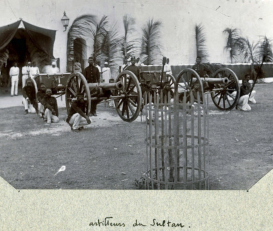
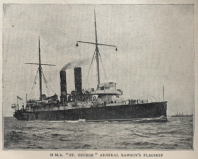
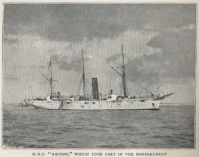
Existential Moments:
The
Zanzibari
response
to
this
marshaling
of
forces
was
continued
defiance
on
the
one
hand
and
diplomatic
maneuvering
on
the
other.
The
British
issued
a
written
ultimatum.
Sultan
Khalid
was
told
that
he
must
quit
the
palace
and
disperse
his
forces
or
the
British
would
attack.
He
was
further
advised
by
the
British
that
"having
usurped
the
Sultanate
of
Zanzibar
without
consulting
the
Protecting
Power
he
had
"committed
an
act
of
open
rebellion
against
the
government
of
her
Britannic
Majesty."
After
that
ultimatum,
the
British
refused
to
negotiate
and would not communicate further with the rebel forces.
Sayyid
Khalid
replied
that
he
would
not
attack
the
Europeans
and
wished
only
for
peace
between
them.
However,
he
also
said
that
he
could
not
abandon
the
Palace,
"his
house
and
the
house
of
his
father."
He
contacted
the
French,
American
and
German
governments
to
seek
their
intercession.
All
refused;
these
countries
each
had
treaty
agreements
with
the
British
that
in
one
way
or
another
deferred
to
the
British
on
all
matters
within
'their'
protectorate.
The
Sultan
asked
the
American
Ambassador
to
deliver
a
message
to
the
English
Queen.
It
read:
"Queen
Victoria,
London.
Hamed
bin
Thuweni
is
dead.
I
have
succeeded
to
the
throne
of
my
forefathers.
I
hope
friendly
relations
will
continue
as
before.
Khalid
bin
Barghash,
Sultan."
This
message was never delivered.
Some
have
suggested
that
these
efforts
to
engage
in
a
long
distance
diplomatic
campaign
indicates
that
the
Zanzibari
were
unaware
of
the
immediate
risks
and
were
foolish
in
not
realizing
how
lethal
the British guns were and how willing the Navy was to use them.
This
is
clearly
wrong.
There
can
be
no
doubt
that
the
Zanzibari
leadership
knew
exactly
how
lethal
the
British
forces
could
be.
Since
as
far
back
as
his
Grandfathers'
reign
some
of
Khalid's
Ministers
had
traveled
to
Europe
and
visited
the
massive
armament
factories
of
the
Industrial
revolution.
They
also
had
among
themselves
years
of
experience
with
naval
gunnery
and
had
watched
the
recent
British military operations in the Indian Ocean with a keen eye.
Regarding
the
seriousness
of
British
threats,
they
had
to
know
that
the
British
showed
no
compunction
about
the
use
of
force
against
those
who
opposed
them.
They
all
knew
of
the
example
made
of
the
city
of
Alexandria
when
in
1882,
this
other
Eastern
City
was
bombarded
for
six
hours
without
pause
by
the
Royal
Navy.
There
may
even
been
a
few
grizzled
veterans
among
the
Sultans'
foreign artillery men who had seen action against the British in that battle some 14 years earlier.
After
Alexandria,
the
willingness
of
British
ships
to
fire
on
densely
populated
cities
was
never
again
in
doubt
in
Africa.
The
Zanzibaris
knew
full
well
what
their
defiant
stance
might
cost
them,
but
still
they
waited.
Not
one
person
abandoned
fortified
Palace.
As
night
fell
Khalid
went
out
to
a
public
Mosque
to
pray
and
to
show
he
was
not
afraid
to
walk
the
streets.
Then
as
the
night
deepened
an
eerie
silence
fell
over
the
City.
Some
witnesses
said
that
"never
had
they
know
a
quieter
night."
Another
wrote
that
"the
silence
was
deep
and
uncanny.....the
noises
of
the
endless
shuffle
of
feet
and
the
clattering
and
rustling
made
by
thousands
of
human
beings
as
they
eat,
work,
play
and
move
about:
all
these
were
stilled,
as
though
the
town
was
breathless with fear and tension."
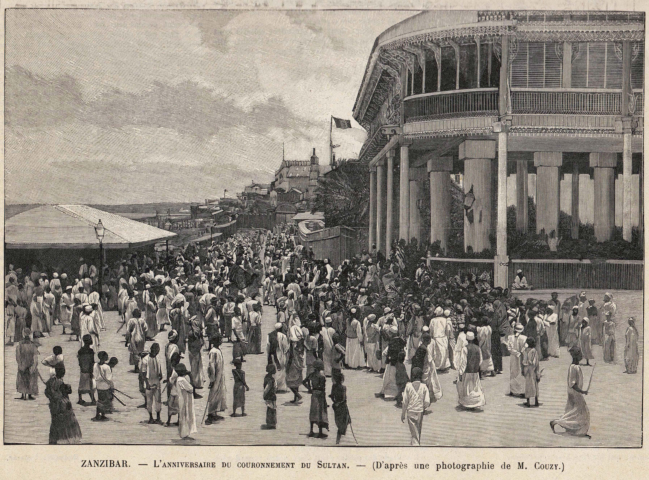
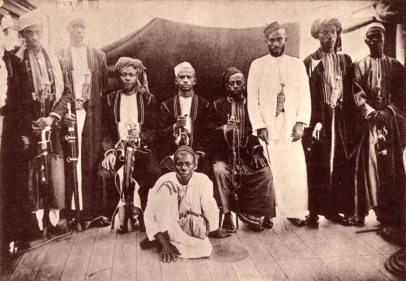
The Battle:
The
morning
of
the
27th
was
clear
and
grew
hot
early
as
many
citizens
assembled
on
the
roof
tops
to
see
what
would
happen.
The
Zanzibari
leaders
again
sent
a
letter
to
the
Americans
asking
that
they
forward
a
telegraph
to
London.
The
American
representative
refused,
saying
that
"as
Khalid
had
not
been
recognized
as
Sultan
by
the
protecting
power,
neither
could
he
be
by
me."
With such diplomatic language was the last, lost chance for peace disposed of.
The
British
ultimatum
had
set
9:00
am
as
the
time
for
the
war
to
begin.
Just
before
that
hour
an
amazing
scene
occurred.
A
small
launch
left
the
Zanzibari
compound
and
rowed
slowly
past
three
of
towering
British
ships.
Its
mission
was
to
deliver
the
Sultans'
Captain
to
his
only
armed
vessel,
a
small
Corvette,
named
after
the
shipyard
from
which
it
was
purchased,
the
H.H.S.
Glasgow.
That
wooden-sided
ship,
more
a
war-yacht
than
a
war
ship,
lay
in
the
harbor,
surrounded
by
the
5
heavily
armored Royal Navy ships.
For
two
days,
the
men
on
board
the
Glasgow
had
made
no
move
to
hoist
anchor
and
escape.
When
their
Captain
arrived
they
solemnly
began
the
final
preparations
needed
to
fire
their
elderly
muzzle-
loading
cannon.
The
British
saw,
by
this
act
of
defiance,
that
no
flag
would
be
lowered
by
the
Zanzibari that morning.
The
Imperial
British
Fleet
fired
precisely
on
time
and
directly
at
the
massed
Zanzibari
men
on
shore.
The
Zanzibari
guns
immediately
fired
back.
At
9:05,
despite
it's
impossible
position,
the
H.H.S.
Glasgow
opened
fire
on
the
British
ships.
The
British
fleet
then
directed
heavy
fire
from
both
sides
onto
the
Glasgow.
Holed
near
the
waterline
she
immediately
started
to
settle
by
the
stern,
firing
all
the time, as she slid lower into the water.
Most
Spectators
fled
the
rooftops
as
misdirected
shells
landed
well
beyond
the
fortified
compound,
setting
fires
in
several
places
within
the
City.
Those
observers
left
aloft
could,
for
a
short
time,
see
the
smoke
from
the
guns
on
both
sides
firing
constantly
but
soon
more
smoke
from
the
fires
touched
off
by
explosions,
obliterated
the
palace
compound
from
view.
Still
the
British
ships
fired
on.
It
has
been
estimated
that
close
to
a
thousand
shells
were
fired
into
Zanzibar
city
that
day.
That
indicates that an explosive shell landed about every three seconds, for the best part of an hour.
Because
of
the
obscured
view,
many
first-hand
accounts
focus
more
on
the
sounds
of
the
battle
rather
than
its
sights.
One
witness
tells
us
that
"for
forty-five
minutes
the
awful
noise
continued:
dull
roars,
punctuated
with
the
crack
crack
of
the
maxims
and
the
snap
of
one-pounders,
the
shells
shrieking
through
the
air
with
splinters
of
them
dropping
about in an indiscriminate manner."
By
9:30
the
brave
Glasgow
was
silent,
all
guns
destroyed,
water
pouring
in
and
many
of
the
crew
dead
or
injured.
Those
who
could
swam
to
shore
while
the
ship
settled
gently
onto
the
shallow
seabed, her masts still showing above the waterline.
Fire
from
the
Zanzibari
guns
on
shore
had
also
slackened,
as
one
outclassed
gun
after
another
was
put
out
of
action.
Even
the
British
fire
lessened,
as
gunners
sought
targets
in
vain
amidst
the
heavy
smoke.
Officers
began
to
look
for
signs
of
surrender.
From
the
sea,
it
could
be
seen
that
the
Harem
building
(Beit
Al
Saleh)
was
burning
fiercely,
as
were
the
warehouses
next
to
the
water.
Then
a
breeze
blew
the
smoke
aside
for
a
moment
allowing
a
clear
view
of
the
large
Palace
flagstaff;
with
the
bright
red
flag
of
Zanzibar
still
flying.
The
British
renewed
their
shelling
with
new
zeal
and
again
the
scene was soon shrouded in smoke.
After
another
15
minutes
of
Bombardment
the
defensive
fire
from
the
shore
had
completely
ceased.
All
Zanzibari
guns
were
out
of
action.
The
British
firing
slowed
and
again
the
flagstaff
came
into
view.
The
top
was
missing,
the
flag
shot
away.
Admiral
Rawson,
in
charge
of
the
Naval
squadron,
took this to mean surrender and therefore ordered his ships to cease fire.
A
somewhat
fictional
account
of
the
final
action
was
provided
by
a
Englishman
writing
only
a
year
after the battle.
"Right
gallantly
the
Askaris
and
Zanzibaris
who
man
the
guns
of
the
usurper
stick
to
their
task,
and
blaze
away
at
the
mailed
sides
of
the
gunboats
without
producing
the
faintest
impression,
until
one
by
one
the
field
pieces
are
dismounted
or
scattered
in
fragments."
The
Royal
Marines
were
then
ordered
in,
to
seize
the
remains
of
palace
at
bayonet
point.
"From
behind
each
sheltering
ironclad
heavily
laden
boats
shoot
out...but
the
landing
of
the
blue-jackets
is
not
to
be
entirely
without
argument
on
the
other
side.
Here
and
there
a
gun
cracks,
and
while
most
of
the
leaden
pellets
splash
harmlessly
in
the
blue
water
of
the harbor, a few find lodgment among the occupants the boats."
The Escape:
With
all
but
their
handguns
destroyed,
and
with
British
marines
coming
ashore
in
droves,
Sultan
Khalid
finally
gave
the
order
to
abandon
the
field
of
battle.
Leaving
some
500
men
dead
in
and
around
the
Palace,
the
Sultan
ordered
his
Zanzibari
irregulars
to
take
up
the
wounded
and
melt
back
into
the
city
suburbs
from
whence they came.
He
then
lead
his
remaining
relatives
and
the
surviving
palace
guards,
on
a
dangerous
march
through
the
city,
towards
the
German
Embassy.
(And
towards
General
Mathews
loyalist
troops
who were entrenched throughout the diplomatic quarter.)
A
witness
who
was
near
that
area
describes
this
scene:
"What
was
my
utter
astonishment
when
I
reached
the
consulate
to
see
a
large
number
of
Arabs
and
their
followers,
headed
by
Khalid,
all
of
them
covered
with
dust
and
blood,
coming
toward
me
and
making
for
the
German
consulate."
When
the
bombardment
started
General
Mathews
had
detached
more
men
to
again
try
to
block
access
routes
into
the
city.
The
most
notable
action
occurred
at
Darajani
Bridge.
There
a
sortie
platoon,
commanded
by
Captain
(later
General)
Arthur
Raikes,
marched
out
and
seized
that
important
bridge
across
the
tidal
creek
separating
Stone
Town
from
its
sprawling
suburbs
to
the
east.
Gunfire
soon
broke
out
when
a
number
of
Khalid’s
supporters
attempted
to
move
towards
the
sounds of the guns, across the bridge and into the city.
Raikes
held
the
bridge
and
repelled
their
advance.
His
men
also
reportedly
shot
several usurpers who tried to get around the bridge by wading across the creek.
While
those
Zanzibar
government
soldiers
were
displaced
to
the
Bridge,
Sayyid
Khalid
was
able
to
bluff
his
way
past
a
group
of
British
marines,
who
had
taken
up
their
defensive
positions
near
the
German
embassy,
but
who
did
not
recognize
the
putative
Sultan.
Khalid
thereby
reached the German compound and immediately requested diplomatic sanctuary.
The
Germans
had
reasons
for
helping
an
opponent
of
the
British
and
so
they
welcomed
him
inside,
along
with
and
a
small
number
of
his
senior
companions.
Khalid’s
other
soldiers
were
disarmed
(their
weapons
were
later
looted)
and
then
released.
They
were
able
to
fade
into
the
interior
of
the
island
while
the
government
troops
and
British
marines
were
distracted
by
the
need
to
control
the
fires near the harbor that blazed so fiercely that they threatened to envelop the city.
Seyyid
Khalid
remained
for
36
days
a
guest
at
the
German
Consulate.
The
British
demanded
he
be
turned
over
to
them
and
surrounded
the
consulate
with
agents
and
soldiers
so
that
he
could
not
escape.
After
weeks
of
diplomatic
wrangling
between
the
two
European
powers
on
Oct.
2nd,
the
morning
of
an
especially
high
tide
when
the
sea
lapped
up
against
the
wall
of
the
German
building,
Khalid
bin
Barghash
stepped
directly
from
the
German
consulate
in
to
a
small
boat,
never
touching
British
controlled Zanzibar soil.
From
there
he
was
conveyed
to
Dar
es
Salaam
where
he
lived
as
a
Prince
in
exile
for
more
than
15
years. Then World War 1 brought him again into conflict with the British Empire.
As
for
the
damaged
city,
the
Beit
El-Hukm
palace
was
destroyed
completely
and
never
rebuilt.
The
Harem
building
next
door
was
devastated
by
explosions
and
fire,
but
a
truncated
replacement
building, using much of the original frame, was soon put up.
The
damage
to
the
lighthouse
in
front
of
the
House
of
Wonders
was
irreparable.
The
Beit
el
Ajaib
(House
of
Wonders)
itself
was
severely
damaged
but
it
was
deemed
repairable.
Therefore,
the
beautiful
old
light
house
was
torn
down
and
a
new
clock-tower/lighthouse
addition
was
added
to
the House of Wonders during its restoration.
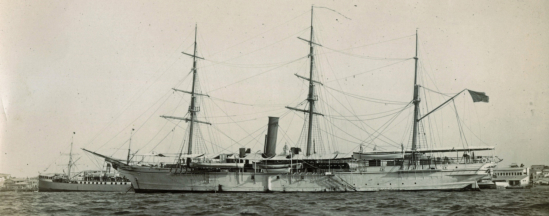
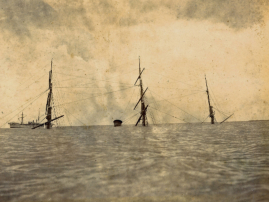
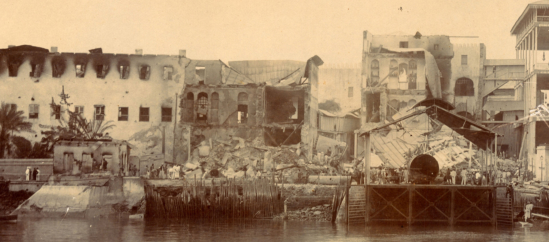
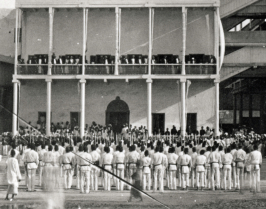
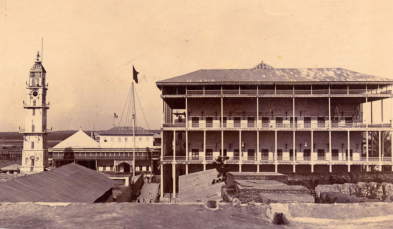
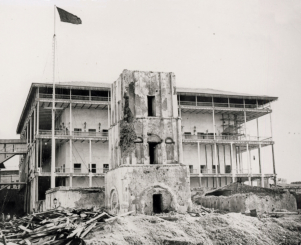
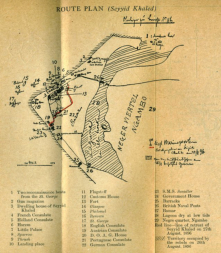
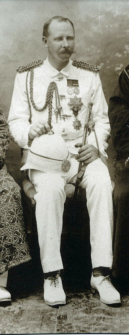
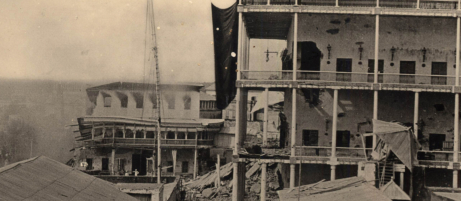
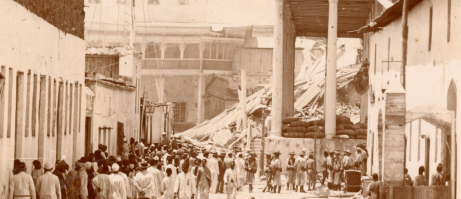
The
day
after
Sayyid
Khalid
left
the
Islands
a
new
Sultan,
Seyyid
Hamoud
bin
Mohamed,
was
invested.
He
promptly
distributed
medals
to
the
British
and
loyalist
troops
who
had
had
supported
his
cause. Among them was General Lloyd Mathews, who was awarded the Brilliant Star of Zanzibar.
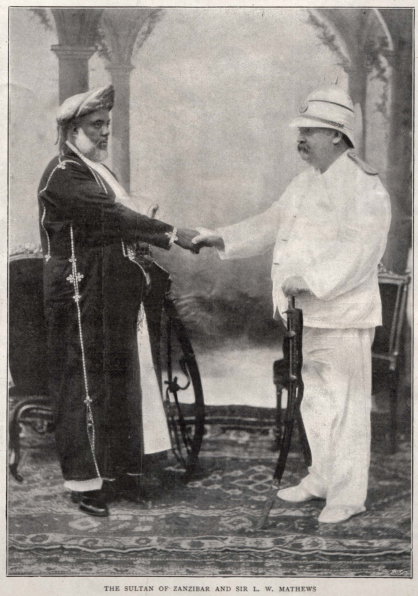
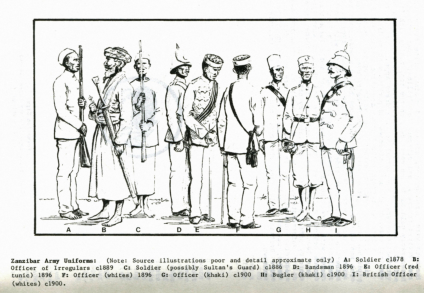
In the 1896 war a committed band of Zanzibari residents faced down the massed
guns of a foreign fleet, many of them died rather than give up their cause.
Theirs is a story that should not be forgotten
Sources
•
Unknown Armies vol.1 Peter Abbot. 1988
•
Zanzibar the Shortest War in History Kevin Patience. 1994
•
In Africa: Victoria Nyanza E Benadir E. A. Dalbertis. 1906
•
Bombardment of Zanzibar R. Dorsey Mohun. 1900
•
Omani Sultans in Zanzibar Ahmed H. Al-Maamiry 1988
•
Sayyid Khalid bin Barghash, three days as a Sultan-thirty years in exile
Heinz Schneppen. 1999
•
A Guide to Zanzibar G. H. Shelswell-White. 1932
•
A. C. and P. F. Gomes, selected Photography 1880-1910
